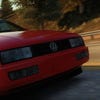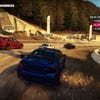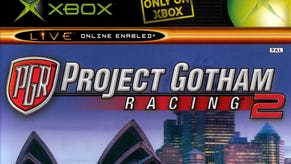Digital Foundry vs. Forza Horizon
Vorsprung durch technik.
Judged in terms of established precedents, Forza Horizon simply has no right to be this good. Handing off the keys to a prestige franchise to an all-new development studio was a massive gamble in itself, but the risk-taking doesn't end there. Playground Games didn't take the obvious safe route and simply iterate on the existing formula using the established engine: instead the fledgling developer took that technology, retained its core attributes and then expanded upon them, taking the whole franchise in a new direction.
From a gameplay perspective, the most significant deviation from previous Forza titles is the departure from the series standard circuit racing, with the new action now transplanted into Colorado. It's an enticing proposition: take the most exciting driving machines money can buy and take them out onto the open road - go anywhere you want, do anything you please. Here, Playground Games faced its first challenge - Forza 4 already pushes the Xbox 360 very close to its limits: the massive engine upgrade envisaged would inevitably require compromise. The solution the studio came up with is the kind that Forza fans are likely to view with suspicion - the series' signature 60Hz update was halved, bringing Horizon more into line with the majority of console games.
It's understandable, of course. Moving to an open world represents some fundamental technical challenges. In a traditional track-based set-up, the developers know that players will effectively be moving in just one direction and can optimise track layout accordingly for best performance - that's a luxury you don't have in rendering an open world. On top of that, there's a significant memory issue too: both Gran Turismo 5 and Forza Motorsport 4 can load almost all the assets required into the existing space available before the race begins.
In a sandbox environment, geometry and textures for environments and cars need to be loaded in and flushed out of RAM during gameplay, meaning that a robust streaming system is required. Assets need to be pulled from DVD within the meagre bandwidth available, then decompressed on the fly before they can be used. There's only one open world racing game we're aware of that runs at 60Hz - Burnout Paradise - and it's telling that Criterion made the same decision that Playground did in dropping down to 30Hz when it came to them rebooting the Need for Speed franchise.
"Playground has done its best to mitigate the impact of dropping down from 60Hz to 30Hz, making the most of the extra processing time."
From 60Hz to 30Hz: the pros and cons
To make up the shortfall somewhat, Playground implements its own form of motion blur in order to reduce the judder imposed by halving the amount of discrete frames that end up on your HDTV. While it can't hope to match the "full-fat" 60Hz experience, it's actually a really impressive piece of tech, seemingly more than just the simple camera blur you may expect. Looking at game captures frame-by-frame, the tech appears capable of picking out specific objects and blurring them individually according to distance from the camera and velocity - an object-based implementation in other words. Combined with the consistent frame-rate it works especially well in chase-cam mode where the camera is drawn back from the action, but its effects in mitigating judder aren't quite as pronounced in first person views where the difference between one frame and the next is that much more pronounced.
Over and above the fluidity of the screen update, the biggest challenge facing Playground in making Horizon feel like a Forza game was in retaining the signature physics and precision response. Forza Motorsport, famously, operates a 360 update per second system to ensure the authenticity of its physics, which ties in directly with the fast response from the 60Hz screen update. You can feel those calculations through the pad: input lag is very low indeed at 66ms - up to twice as responsive as many other racers we've played. Dropping down to 30Hz can have a fundamental impact on that low latency response. Up until now, only Criterion has managed to get close to giving that precision feel in a 30Hz title - famously, Need for Speed: Hot Pursuit cuts frame-rate in half compared to Burnout Paradise (and indeed, Forza Motorsport) but only adds 16.67ms - or one single frame - of additional latency.
Our input lag tests - measured with a combination of a Ben Heck latency controller monitor board and a high speed camera - suggests that Horizon adds two additional frames of latency to that found in Forza Motorsport 4, giving a total of 100ms. This isn't quite the same level of achievement as Need for Speed: Hot Pursuit (which based on the games we've measured is the most responsive 30Hz game ever made) but it's damn close. Indeed, prior to the release of NFS, many believed that 100ms was the lowest input latency possible on a 30Hz current-gen title.
"The precision CG look of Turn 10's titles gives way to a softer, more filmic aesthetic in this heavily post-processed alternative vision of the Forza universe."
Side-by-side with Forza 4, the difference can definitely be felt, but the move to 30Hz pays off in many other regards. Processing time per frame is doubled, opening up a whole new world of possibilities to the Playground developers. Key Forza 4 engine systems could be adapted, enhanced and improved with the additional time available. The most dramatic change is in the lighting. The existing Forza engine is no slouch here - the image-based lighting of Need for Speed: Hot Pursuit (a technique that "wraps" the environment around the cars) was impressive running at 30Hz, but it becomes a thing of beauty at twice the frame-rate. Gamma correct HDR is also implemented, ensuring that detail stands out in all lighting conditions.
Forza Horizon adds to that: a full time of day lighting system has been implemented, meaning that lighting conditions change radically as we move from day to night and back to day. Horizon offers dynamic shadows rendered according to the position of the sun, and these are implemented on both environments and vehicles. There are still compromises though - headlights don't seem to be the fully dynamic light sources you'd hope them to be, with limited illumination of cars up ahead and no additional brightness to the lighting when multiple beams intersect. In addition, there are no real-time reflections from the other cars, just from the environment. That 33.33ms rendering time can only go so far and it's case of Playground picking the trade-offs it felt were best. [Updated: small clarification on night-time lighted added.]
Image quality: solid, consistent, refined
In terms of image quality, Forza Horizon is clean. Extremely clean. In fact, you've got to work really hard to come up with any other 360 game that gets close - the later DiRT titles are probably the nearest parallel. In Codemasters' accomplished racing titles, hardware 4x multi-sampling is utilised which in concert with some impressive post-processing effects yields some impressive results. But Forza Horizon goes beyond that. In an era where game developers are killing off the memory and bandwidth-intensive MSAA in favour of the much cheaper post-process equivalents, Playground's solution is comparatively lavish. Not only is 4x MSAA retained - in line with the replays and time trials of Forza Motorsport 4 - FXAA is added too. According to the developer, this is dynamically applied when there is GPU time left over.
This isn't simply a post-process on the final framebuffer though - instead FXAA works its magic on intermediate render targets. The net result is that while the FXAA blending is perhaps blurrier than we're used to, it cleans up a lot of things - motion blur, shadow penumbra and tree foliage. The trade-off works because the game's aesthetic does not rely on intricate artwork - the cars have mostly flat panels and few high-frequency, noisy textures. In this implementation, FXAA becomes part of the post-process pipeline as opposed to a plain and simple filter as it is used more generally.
"The developers have worked obsessively to remove aliasing artifacts from Forza Horizon and their efforts have paid off. The game combines top-end 4x MSAA with additional dynamic FXAA processing added too."
The solidity of the game in this regard is hugely impressive. Aliasing is all but eliminated, but the impact to the overall aesthetic goes beyond simple edge-smoothing. Specular highlighting problems are completely absent, meaning that shiny surfaces (bodywork for example) blend in the metallic sheen and reflections beautifully. The negative LOD bias we've seen on Turn 10's Forza titles - where ultra-high detail road textures create a moiré-like pattern in the relatively limited 720p resolution available - is also gone with what looks like a more traditional bilinear texture-filtering algorithm in place. The immense level of detail isn't quite there, but the shimmering artifacts we saw in Forza 4 are simply not an issue here.
Also worthy of praise is the consistency in the visuals. Bearing in mind the extreme view distances (go high enough and you can see one end of the map from the other) along with the richness of the environments in terms of graphical detail, it's impressive that there's no pop-in whatsoever during the normal run of play. Only isolated instances stood out to us, specifically some infrequent LOD-popping on the cars that manifests on the odd occasion as they move closer to the player, alongside very rare glitching on far-off environmental detail. The overall consistency is especially noteworthy when you factor in the variety in the scenery - mountainous routes, flat, open fields, densely populated forests, towns of varying sizes, closed-off rally style circuits - the engine manages to process them all equally well.
Effects work is also impressive. Taken as individual components - whether you're talking about the dynamic time of day, the hazy atmospheric rendering, the sun-shafts implementation, the motion blur, water shaders or the reflections - it's difficult to find fault with any aspect of the presentation. Reflections operate at the same frame-rate as the game (in many titles, they don't), while the god-rays are more subtle, better blended and more refined than they are in, say, Unreal Engine 3's take. Car window transparencies are also well handled, especially with the glare reflection, featuring very clean reflections when it comes to the sun hitting the glass.
Forza Horizon: performance analysis
The dynamic application of FXAA is just about the only hint that the revised Forza engine is under any kind of stress because frame-rate is absolutely rock solid at the target 30 frames per second. There are no dropped frames and there's absolutely no screen-tear. This in itself is a remarkable achievement.
In an age where developers are pushing console hardware to its limits, it's understandable that we should see some compromises in overall performance. The process involved in anticipating every possible rendering contingency in any given 33.33ms time period must be remarkable factoring in immensely variable elements like environmental rendering load, number of vehicles on-screen, post-process effects work. Anything can happen in a game and it's hard to imagine that developers can factor in every possible contingency to the render budget. Compromise to some extent is mostly inevitable as we see in most games released today: whether it's down to performance dips, screen-tear, dynamically adjusted LODs on cars/draw distance or even dynamic resolution adjustment as we see in idtech 5 titles, Ninja Gaiden 3 and even the forthcoming Metal Gear Rising.
"Most console games target 30FPS, but dropped or torn frames are commonplace. Playground Games has adopted a zero compromise approach with Forza Horizon and it makes a clear difference."
Somehow, Horizon manages to maintain its exceptional standards with a level of consistency we rarely see in modern gaming. Playground tells us that it's all down to anticipating the absolute worst case scenarios in CPU and GPU usage, then allocating processing budgets accordingly. Tech and design teams work in concert to ensure that those budgets are not exceeded under any circumstances whatsoever. Targeting a single platform also helps in that the developers don't need to work to the common lowest denominator on any particular piece of code.
The end result is a game where the player has absolute consistency from the controls, and a fluidity in screen update that only a tiny minority of AAA titles have matched. Earlier, we noted that the majority of console games run at 30FPS. A few minutes in the company of Forza Horizon makes you realise that this isn't strictly true: most console games target 30FPS - Playground's debut offering is remarkable in that it actually hits that target without fail, transforming the experience. We've been conditioned to accept that frame-drops and screen-tear are necessary evils: in this respect, Forza Horizon is refreshingly compromise-free.
Forza Horizon: the Digital Foundry verdict
As a technical achievement, Forza Horizon is outstanding. It possesses all the fundamental strengths of the Forza Motorsport engine, compromising in one key aspect - frame-rate - but reaping the considerable rewards in almost every other. The overall look and feel of the game is almost untouchable, with an extremely high standard of production values applied to almost every visual element - everything meshes together beautifully, making for a best-in-class presentation. While input latency lags behind the Turn 10 series staples owing to the frame-rate cut, Forza Horizon still works well because once you've adjusted to the feel of the controls, the response is absolutely rock solid.
Any controversy surrounding the game is certainly not down to the lower frame-rate, but centred more the melding of Need for Speed-style arcade racing with the technical precision of the Forza Motorsport engine. No doubt there will be allegations that Playground has "dumbed down" Turn 10's vision, that in an age where racing games struggle to make an impact on the market, Horizon is a calculated attempt to produce a more mainstream-friendly product. Others may not be so impressed with the continuation of in-game micro-transactions (a "fast-track" on gameplay progression), the upcoming monthly roll-out of DLC and an almost "trendy Vicar"-style of enforced hipness to the festival proceedings that doesn't quite ring true.
But make no mistake - this is very much the "custom thoroughbred" described by Oli in the 9/10 Eurogamer review, a release where the developers hand over the simulation and difficulty controls to the player and actively invite them to make the game as arcade-like or as authentic as they wish. Out of the box, Horizon is as mainstream and as inviting as it could possibly be and to be frank, while it's immense fun, it's not particularly challenging. But for the purists, all the Forza engine DNA is still there - assists can be tweaked to taste and difficulty level of the opponents can be shifted on a race-by-race basis. Fittingly for a series built upon a foundation of customisation, it's a game that demands to be tuned to taste.



























